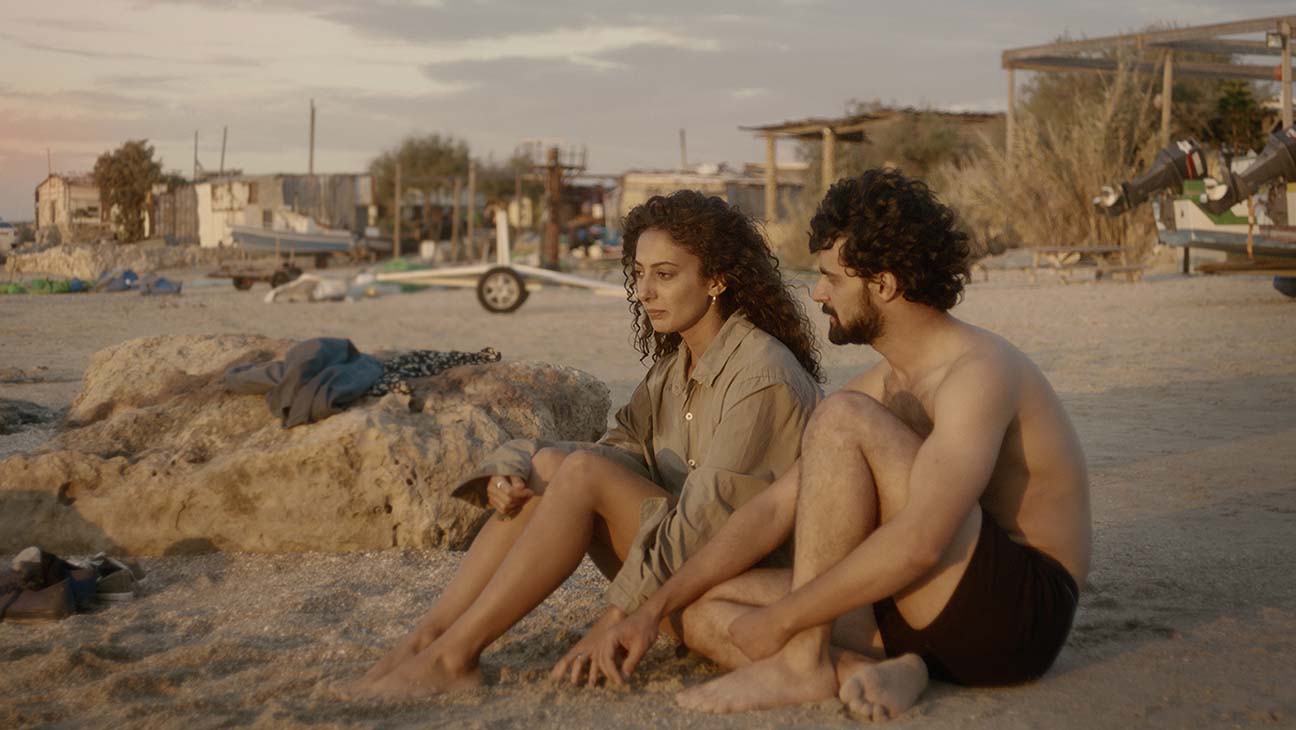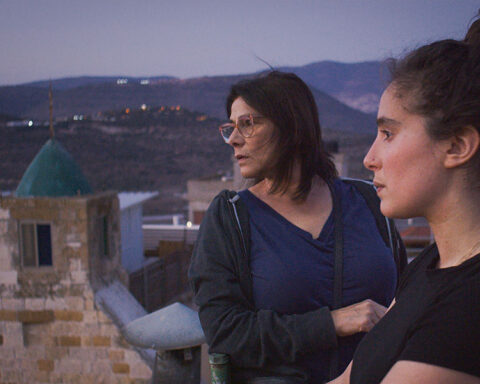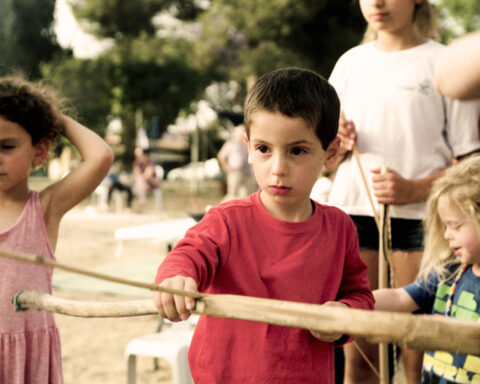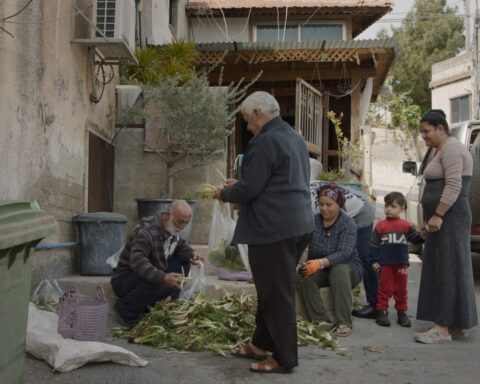Using a VPN to change my IP address to Canada so I could access the Toronto Palestine Film Festival (TPFF) is the closest I’ve gotten to travelling in 2020 and I’m not mad. No stamp in my passport here folks, just a renewed devotion to the power of storytelling, fascination at the flexibility of the documentary form, and a grounding self-awareness.
TPFF really went above and beyond to ensure their transition to the virtual world was seamless. On their webpage, each program was organized by date with a timed release. Festival-goers could watch live or off-schedule for up to two days. The only down-side being, just like many other streaming services, once a viewer bought their ticket to a particular film, their access would expire after 24 hours. This posed a challenge when I wanted to watch a film over and over and over (this happened a couple of times). To stand in for one of the amenities usually enjoyed in person, TPFF partnered with Toronto’s favourite Palestinian restaurants available for order complete with special menu items and discounts for “Sahtain-At-Home.” I asked if they delivered to Brooklyn…they said no.
Against Erasure/Non-Film Features of the Festival
Being that Palestine is under occupation by the disreputable settler-colonial state of Israel, protecting and limelighting the multifaceted dimensions of Palestinian culture in its own land as well as across the international diaspora, one must recognise that one tactic of occupation is erasure. Resistance to this tactic was brought up by many in the festival. One person in particular was Mirna Bamieh, who talked to TPFF and a Zoom audience about her live art collective, “Palestinian Hosting Society.” Mirna’s fieldwork involves meeting with elders in cities and villages across Palestine to gather endangered recipes as well as their associated stories. The cause of endangerment ranges from appropriation by Israelis (see: Israeli couscous—as if that was a thing), lack of access to critical ingredients due to racist legislation in Palestine or being forgotten as younger generations spread across the globe, losing connection to the land and their history. As a result of this ongoing research, Mirna hosts feasts in various cities internationally. It may seem odd to kick off a review of a film festival with a food justice performance art project but Palestinian Hosting Society does something we look for in film as well. At its core is storytelling. Additionally, it charges the seemingly mundane with an acute political message. Without getting too theoretical, I appreciated the festival’s curatorial decision to include this presentation as well as other similar features such as author of You Exist Too Much, Zaina Arafat and textile artist, Samar Hejazi. More on that later.
Resisting Borders:
I was originally drawn to the festival thanks to the Palestinian Youth Movement newsletter, so it was important for me to check out the three-part short film series they co-presented with other social justice organizations: the Arab American National Museum, Arab Film and Media Institute, ArteEast, and National SJP. It was called the “Resisting Borders” series, a title that didn’t click for me until I reached the end and took a step back. Only then did I realize the poetic transgression they shared.
Olga Arias Muñiz’s documentary Jalas featured three adolescent Palestinian girls living in three separate cities. Each girl was representative of a different lifestyle—a different gradation of liberty in their own country—which the director used to highlight how the occupation has divided the nation dramatically. Tasneem lives in East Jerusalem, Baraa in Dheisheh Refugee Camp, and Rima in Haifa. When the director narrated over footage of the three girls meeting for the first time, after their individual spotlights, she pointed out that if not for this film, it was highly unlikely that these three girls would have otherwise met due to unjust travel restrictions. For example, between Tasneem and Rima are 100 checkpoints within about 94 miles. That’s about the same distance as between New York City and Philadelphia. Muñiz also points out that only 30% of Palestinians in the West Bank hold a special permit to cross the wall that separates them from Israel, which Haifa is technically in. In the film, Rima is able to take trips to the West Bank where she can speak Arabic instead of the Israeli Hebrew and feel comfortable among a majority Arab population but she admits that it is not so easy for Arabs in the West Bank (such as Baraa and Tasneem) to travel in reverse. Jalas resists borders by bridging the gaps between these three cities, between these three girls. One of the more statistically informative films of the festival, it also reached across the globe and resisted the normalization of internal division, among other things, occurring in Palestine.
In Saeed Taji Farouky’s Strange Countries are Familiar what resists borders is the painful trauma imposed by the wars that Ashraf has fought in. Though he has sought asylum in London and has resided there for 30 years, he has PTSD so anywhere he goes the trauma follows. The memories of the wars at home play out before him on the safe streets of his new city. He thinks he’s seen a mother in a tent city holding a baby while Ashraf asks her, “Where will you go?” A man is shot and his blood pools around him while a woman cries over his body and the neighbors watch. These events are so real that after one, Asraf runs into a cafe to seek help and ends up collapsing. When his own son bleeds from a gunshot wound incurred at a protest, on the table of his social club, I had trouble trusting that it was real. It became hard to distinguish between what was and wasn’t, which I can imagine is how Ashraf feels as well. His son was indeed shot but thousands of miles away, not in his social club during a card game. Nevertheless, Ashraf’s worlds have merged, London and Palestine. In this way, his pain resists borders.
In Suha Araj’s drama Rosa, there is a physical border crossed but in an untraditional way. The bodies are dead, packaged discreetly, and shipped in a private plane at a hefty price. Rosa is a florist but her side hustle deals with the spirit world. She sends people home for their final rest, to put their soul back at peace after doing the work it set out to do by coming to the United States. Ali, an Iraqi man feels guilt after the unexpected passing of his father because after enticing him to join him in the US for better medical treatment, his dying wish was to go back home. In order to keep his word, Ali calls Rosa who started in this line of work after doing the same for her mom. The operation highlights the importance of tradition and honour as well as how American life distorts those very things. In the film, money is used to replicate them by any means possible which reminded me just how much is sacrificed by leaving one’s land.
(dis)Connection to Land
Another documentary, this time by TPFF filmmaker-in-residence Rana Nazzal looks at the consequences of this separation from one’s land from another perspective. The subjects of Something From There are Nazzal’s family members, those with the appropriate passports and paper that allow them to travel more freely than others, a symptom of a violent bureaucracy that thinks it has the right to use pieces of paper to give or take human rights from individuals. These “fortunate” family members travel to lost lands and collect soil to bring back—a piece of the land. This gift is better than a photo because a photo is static and removed. The soil is alive and present.
Nidal Ali Rafa, co-director and protagonist of the incredible documentary, Abbas 36 (co-directed by Marwa Jbara-Tibi), brings a similar gift when she visits Jamal Abu-Ghaida in Doha, Qatar. Jamal’s family fled from the house Nidal currently resides in as a result of the Nakba or “catastrophe” of 1948, when Israel officially claimed nationhood, and expelled over 700,000 Palestinians from their home. Nidal’s gift was a bowl’s worth of sand and seashells from the beach in Haifa and a tree branch from outside Jamal’s old house, Nidal’s current home. In both films, the displaced characters speak of and long for “the scent of home,” of which such gifts attempt to offer. Nazzal’s mother in Something from There asks, “Would a free person ask for such a gift?” Well, no. If they were free they could go there themselves, or they would still be living on their land and they would smell it every day. They wouldn’t be, instead, living in another city or country with only the chance for a 24-hour visa to visit their homeland. Or even more absurdly, have to pay for tickets because their homeland has been turned into an archeological site and tourist attraction. This was the case for Saeed Abu Elnaj in Abbas 36 ,whose family was displaced from their village Saffouryeh. His wife, Dina Abu-Ghaida, like Jamal, would be living at the house on Abbas Street had her family not been forced to flee in 1948.
Samar Hejazi, a textile artist featured in the festival broached the same topic but instead of film, she used threads. She too asked, “What is a person who is separated from their land?” By using traditional Palestinian embroidery methods, Hejazi removed the support of the fabric and displays only the patterned thread-work, symbolizing people without their land. She makes the point that just as the threads hold themselves together without the support of the backing fabric, Palestinian people are still Palestinian people even when their land is annexed and occupied. Furthermore, the threads are not solely holding themselves together, they are ornate and beautiful and a work of art entirely on their own, reminiscent of the past but also radically reinvented. This sentiment reminds me of a scene in /Abbas 36 when Dina Abu-Ghaida expresses a variance in her attitude towards being a Palestinian in the diaspora. She says, “How can I explain it, sometimes I wake up in the morning feeling completely lost. I have no homeland, no home.” But on the other hand she also reminds herself that she is now a citizen of the world, lucky to belong to so many places: Jerusalem, Haifa, Vienna, Beirut, and Washington D.C.. “How many people can say that?,” she asks.
Surveillance
Surveillance was another theme that persisted throughout the festival. It came up as early as the opening film, the drama Between Heaven and Earth by Najwa Najjar, the plot of which truly deserves its own article; it’s my favourite overall. Tamer and Salma are sitting in a park in the Galilee region (possibly Nazareth) outside what Tamer has just learned was his father Ghassan’s last Palestinian address before he moved with him to Beirut—where he was later murdered for his political journalism. Tamir, the current resident of the house and son of Ghassan’s former lover, Hagar, has called the cops on Salma and Tamer for “trespassing” when they went to the house to ask for information from Tamir related to the divorce they are trying to file. The couple is discussing whether their residence in the West Bank was to blame for the deterioration of their marriage and Tamer suggests moving to another city or even applying for asylum in Australia, a proposition Salma laughs at. She reminds him that as Arabs, anywhere they go there will be soldiers and police watching. With perfect timing, a squad car then pulls up and arrests the couple. Salma grins and jokes that they are now back to normal after an undisturbed couple of hours across the border.
This kind of surveillance is not so foreign to us in New York. Besides the obvious similarities between the NYPD (New York Police Department) and the Israeli Military—both being oppressive, racist organizations—the two are actually closer than what is popularly known. Since 2002, thousands of American law enforcement officials—mostly from the NYPD—have been participating in an exchange program with Israel where tactics and technologies are shared to better profile and repress racial minorities in everyday policing practice. Another focus of the “education” is protest suppression and anti-terrorism. The Anti-Defamation League (ADL) also has its own program for lectures and trainings between Israel and the US. The NYPD even has a branch in Israel since 2012 with the intention of gathering intelligence. For more information see Jewish Voice for Peace’s 2018 report, The Deadly Exchange.
Kamal Aljafari’s experimental film An Unusual Summer made a bold statement about this culture by shooting the entire film from one security camera installed on the front of his father’s house after an act of vandalism. Presented in the style of an old silent film, with sped up action, dramatic music, and periodic cuts of text on a black screen, Aljafari created an acutely poetic and political document of life in his city, Ramla. In one text shot we read, “On my father’s camera / everyone has a chance to exist.” What a twisted way to think about surveillance!
Finally, in Mayor by David Osit, some Ramallah youth are on the roof of their house looking at the Jewish settlement only “a stone’s throw away.” One girl says “It feels like they’re suffocating us. Even when they’re not doing anything, it’s suffocating.” They wonder if their city is all gone until one boy suggests they throw parties on their roofs, “So they could see us celebrating. Just because you can put us in a slum, we can still party.” Mayor Musa Hadid, the subject of the film expresses a similar struggle when he admits that his power is limited. He strives to perform his municipal responsibilities such as installing a fountain and putting up a giant lit tree for Christmas (Ramallah is a majority Christian city). Yet despite his efforts, Israeli soldiers can break into the city whenever they please to terrorize his citizens; in one scene, they even shoot a man and then take selfies in front of the Christmas tree. Mayor Hadid expresses jealousy towards other leaders, free to make their own choices for their city. After an attack he says to reporters, “I think they’re trying to remind us we’re still under occupation. But we’d never forget the occupation exists. What Ramallah is witnessing these days is an attempt to humiliate us and show us that they’re always here. Whatever you do, this land is ours. This city is ours. All your attempts to control this city will fail.”
Conclusion
The best part of a festival is, of course, the privilege of hearing the cast and crew talk about the work that has just possibly stunned your eyeballs. This was a feature not lost during the virtual transition of the festival and each event was insightful as well as educational. Directors Najwa Najjar of Between Heaven and Earth and Marwa Jbara-Tibi of Abbas 36 were particularly compelling and often shared certain sentiments. They were both committed to what shouldn’t be so uncommon or radical but more often than not, is. That being, putting the representation of Palestinians in the hands of Palestinians for a Palestinian audience. “I was thinking,” said Jbara-Tibi, “how the Palestinian will see their own story.” This reminded me of author of You Exist Too Much, Zaina Arafat, and her interview with George Abraham. She talked about intentionally not translating the brief moments of Arabic in the dialogue of her novel despite pressure to be inclusive to a Western audience. Her point was that the unfamiliarity reminds a Western reader that the work is not for them—not for me, for example. But everything does not have to be accessible to us. That assumed privilege is part of a toxic power structure which moments like those Arafat created—uncomfortable moments—chip away at and unpack. At least I hope. And anyway the internet is at our service, people. It’s not the end of the world to have to do some independent research. We might even have fun in the process.
Jbara-Tibi also said, “I am sick and tired of being always crying…in the filmmaking. I want to be proud and tell my own story from a powerful POV. Not from a weak POV. Not from a ‘how poor we are as Palestinians’ POV…no. [Rather] ‘how strong we are as Palestinians’ and ‘how we deserve to get our rights.’ And that’s why maybe Abbas is different from other [films].” Najjar also made the point that, “The way our land is shown…the way our lives are shown. That’s not our lives.” A skillful detail I didn’t originally notice which supported this intention was the pool scene in the beginning of Between Heaven and Earth. This, along with protagonist Salma’s Mercedes Benz and the contemporary decor of her house, created a Palestinian middle class that exists but is rarely depicted. Najjar said the choice came from her discomfort with Palestinians being constantly depicted as ‘pathetic’. “Why not break some stereotypes?” she asked with a smile. This question was certainly asked in the production of all of the films featured at TPFF both in form and content.












